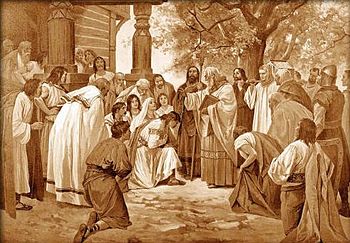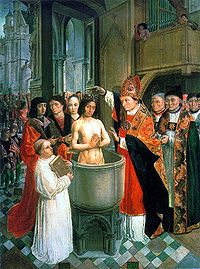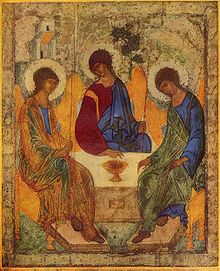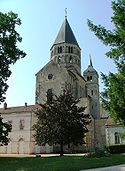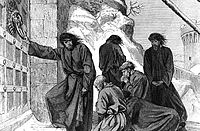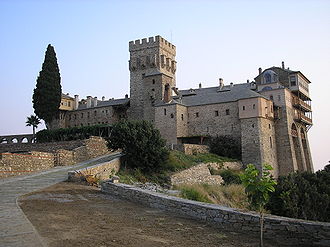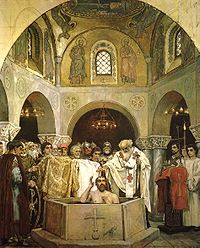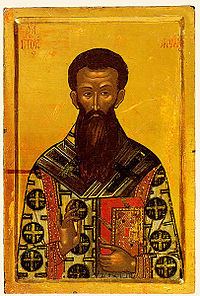- History of medieval Christianity
-
Main article: History of ChristianitySee also: History of late ancient Christianity and History of modern Christianity
The history of medieval Christianity traces Christianity during the Middle Ages - the period after the Fall of Rome (c.476) until the Protestant Reformation (c.1517), considered the start of the modern era.
Included in this period is the Age of Discovery, during which Christianity became the world's largest religion.[1]
Among the dioceses, five held special eminence: Rome, Constantinople, Jerusalem, Antioch, and Alexandria, generally referred to as the Pentarchy. The prestige of most of these sees depended in part on their apostolic founders, or in the case of Byzantium/Constantinople, that it was the new seat (New Rome) of the continuing Roman or Byzantine Empire. These bishops considered themselves the spiritual successors of those apostles.[citation needed] In addition, all five cities were Early centers of Christianity.
Contents
- 1 Early Middle Ages (476–799)
- 2 High Middle Ages (800–1300)
- 3 Late Middle Ages (1300–1499)
- 4 See also
- 5 Notes
- 6 Print resources
- 7 External links
Early Middle Ages (476–799)
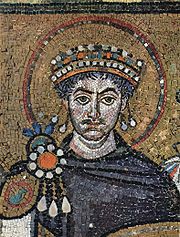 Mosaic of Justinian I in the church of San Vitale, Ravenna, Italy
Mosaic of Justinian I in the church of San Vitale, Ravenna, Italy See also: Christianity in the 6th century, Christianity in the 7th century, and Christianity in the 8th century
See also: Christianity in the 6th century, Christianity in the 7th century, and Christianity in the 8th centuryThe Early Middle Ages commenced with the deposition of the last Western Roman emperor in 476, to be followed by the barbarian king, Odoacer, to the coronation of Charlemagne as "Emperor of the Romans" by Pope Leo III in Rome on Christmas Day, 800. The year 476, however, is a rather artificial division.[2] In the East, Roman imperial rule continued through the period historians now call the Byzantine Empire. Even in the West, where imperial political control gradually declined, distinctly Roman culture continued long afterwards; thus historians today prefer to speak of a "transformation of the Roman world" rather than a "fall of the Roman Empire." The advent of the Early Middle Ages was a gradual and often localised process whereby, in the West, rural areas became power centres whilst urban areas declined. With the Muslim invasions of the seventh century, the Western (Latin) and Eastern (Greek) areas of Christianity began to take on distinctive shapes. Whereas in the East the Church maintained its structure and character and evolved more slowly, in the West the Bishops of Rome (i.e., the Popes) were forced to adapt more quickly and flexibly to drastically changing circumstances. In particular whereas the bishops of the East maintained clear allegiance to the Eastern Roman Emperor, the Bishop of Rome, while maintaining nominal allegiance to the Eastern Emperor, was forced to negotiate delicate balances with the "barbarian rulers" of the former Western provinces. Although the greater number of Christians remained in the East, the developments in the West would set the stage for major developments in the Christian world during the later Middle Ages.
Early Medieval Papacy
After the Italian peninsula fell into warfare and turmoil due to the barbarian tribes, the Emperor Justinian I attempted to reassert imperial dominion in Italy from the East, against the Gothic aristocracy. The subsequent campaigns were more or less successful, and an Imperial Exarchate was established for Italy, but imperial influence was limited. The Lombards then invaded the weakened peninsula, and Rome was essentially left to fend for itself. The failure of the East to send aid resulted in the popes themselves feeding the city with grain from papal estates, negotiating treaties, paying protection money to Lombard warlords, and, failing that, hiring soldiers to defend the city.[3] Eventually the popes turned to others for support, especially the Franks.
Spread beyond the Roman Empire
 Christians and Pagans, a painting by Sergei Ivanov
Christians and Pagans, a painting by Sergei Ivanov
As the political boundaries of the Roman Empire diminished and then collapsed in the West, Christianity spread beyond the old borders of the Empire and into lands that had never been under Rome.
Irish and Irish missionaries
Beginning in the fifth century, a unique culture developed around the Irish Sea consisting of what today would be called Wales and Ireland. In this environment, Christianity spread from Roman Britain to Ireland, especially aided by the missionary activity of St. Patrick. Patrick had been captured into slavery in Ireland and, following his escape and later consecration as bishop, he returned to the isle that had enslaved him so that he could bring them the Gospel. Soon, Irish missionaries such as SS. Columba and Columbanus spread this Christianity, with its distinctively Irish features, to Scotland and the Continent. One such feature was the system of private penitence, which replaced the former practice of penance as a public rite.[4]
Anglo-Saxons, English
Although southern Britain had been a Roman province, in 407 the imperial legions left the isle, and the Roman elite followed. Some time later that century, various barbarian tribes went from raiding and pillaging the island to settling and invading. These tribes are referred to as the "Anglo-Saxons", predecessors of the English. They were entirely pagan, having never been part of the Empire, and although they experienced Christian influence from the surrounding peoples, they were converted by the mission of St. Augustine sent by Pope Gregory the Great. Later, under Archbishop Theodore, the Anglo-Saxons enjoyed a golden age of culture and scholarship. Soon, important English missionaries such as SS. Wilfrid, Willibrord, Lullus and Boniface would begin evangelising their Saxon relatives in Germany.
Franks
See also: Franks and MerovingianThe largely Christian Gallo-Roman inhabitants of Gaul (modern France) were overrun by Germanic Franks in the early 5th century. The native inhabitants were persecuted until the Frankish King, Clovis I converted from paganism to Roman Catholicism in 496. Clovis insisted that his fellow nobles follow suit, strengthening his newly-established kingdom by uniting the faith of the rulers with that of the ruled.
Frisians of the Low Countries
In 698 the Northumbrian Benedictine monk, Willibrord was commissioned by Pope Sergius I as bishop of the Frisians in what is now the Netherlands. Willibrord established a church in Utrecht.
Much of Willibrord's work was wiped out when the pagan Radbod, king of the Frisians destroyed many Christian centres between 716 and 719. In 717, the English missionary Boniface was sent to aid Willibrord, re-establishing churches in Frisia and continuing to preach throughout the pagan lands of Germany. Boniface was killed by pagans in 754.
Iconoclasm
Main article: Iconoclasm (Byzantine)Iconoclasm as a movement began within the Eastern Christian Byzantine church in the early 8th century, following a series of heavy military reverses against the Muslims. Sometime between 726–730 the Byzantine Emperor Leo III the Isaurian ordered the removal of an image of Jesus prominently placed over the Chalke gate, the ceremonial entrance to the Great Palace of Constantinople, and its replacement with a cross. This was followed by orders banning the pictorial representation of the family of Christ, subsequent Christian saints, and biblical scenes. In the West, Pope Gregory III held two synods at Rome and condemned Leo's actions. In Leo's realms, the Iconoclast Council at Hieria, 754 ruled that the culture of holy portraits (see icon) was not of a Christian origin and therefore heretical.[5] The movement destroyed much of the Christian church's early artistic history, to the great loss of subsequent art and religious historians. The iconoclastic movement itself was later defined as heretical in 787 under the Seventh Ecumenical council, but enjoyed a brief resurgence between 815 and 842.
High Middle Ages (800–1300)
See also: Christianity in the 9th century, Christianity in the 10th century, Christianity in the 11th century, Christianity in the 12th century, and Christianity in the 13th centuryCarolingian Renaissance
The Carolingian Renaissance was a period of intellectual and cultural revival during the late 8th and 9th centuries, mostly during the reigns of Charlemagne and Louis the Pious. There was an increase of literature, the arts, architecture, jurisprudence, liturgical and scriptural studies. The period also saw the development of Carolingian minuscule, the ancestor of modern lower-case script, and the standardisation of Latin which had hitherto become varied and irregular (see Medieval Latin). To address the problems of illiteracy among clergy and court scribes, Charlemagne founded schools and attracted the most learned men from all of Europe to his court, such as Theodulf, Paul the Deacon, Angilbert, Paulinus of Aquileia, and Alcuin of York.
Growing tensions between East and West
The cracks and fissures in Christian unity which led to the East-West Schism started to become evident as early as the fourth century. Cultural, political, and linguistic differences were often mixed with the theological, leading to schism.
The transfer of the Roman capital to Constantinople inevitably brought mistrust, rivalry, and even jealousy to the relations of the two great sees, Rome and Constantinople. It was easy for Rome to be jealous of Constantinople at a time when it was rapidly losing its political prominence. Estrangement was also helped along by the German invasions in the West, which effectively weakened contacts. The rise of Islam with its conquest of most of the Mediterranean coastline (not to mention the arrival of the pagan Slavs in the Balkans at the same time) further intensified this separation by driving a physical wedge between the two worlds. The once homogenous unified world of the Mediterranean was fast vanishing. Communication between the Greek East and Latin West by the 600s had become dangerous and practically ceased.[6]
Two basic problems — the nature of the primacy of the bishop of Rome and the theological implications of adding a clause to the Nicene Creed, known as the filioque clause — were involved. These doctrinal issues were first openly discussed in Photius's patriarchate.
By the fifth century, Christendom was divided into a pentarchy of five sees with Rome accorded a primacy. The four Eastern sees of the pentarchy, considered this determined by canonical decision and did not entail hegemony of any one local church or patriarchate over the others. However, Rome began to interpret her primacy in terms of sovereignty, as a God-given right involving universal jurisdiction in the Church. The collegial and conciliar nature of the Church, in effect, was gradually abandoned in favour of supremacy of unlimited papal power over the entire Church. These ideas were finally given systematic expression in the West during the Gregorian Reform movement of the eleventh century. The Eastern churches viewed Rome's understanding of the nature of episcopal power as being in direct opposition to the Church's essentially conciliar structure and thus saw the two ecclesiologies as mutually antithetical. For them, specifically, Simon Peter's primacy could never be the exclusive prerogative of any one bishop. All bishops must, like St. Peter, confess Jesus as the Christ and, as such, all are Peter's successors. The churches of the East gave the Roman See, primacy but not supremacy. The Pope being the first among equals, but not infallible and not with absolute authority.[7]
The other major irritant to Eastern Christendom was the Western use of the filioque clause—meaning "and the Son"—in the Nicene Creed . This too developed gradually and entered the Creed over time. The issue was the addition by the West of the Latin clause filioque to the Creed, as in "the Holy Spirit... who proceeds from the Father and the Son," where the original Creed, sanctioned by the councils and still used today, by the Eastern Orthodox simply states "the Holy Spirit, the Lord and Giver of Life, who proceeds from the Father." The Eastern Church argued that the phrase had been added unilaterally and, therefore, illegitimately, since the East had never been consulted.[8] In the final analysis, only another ecumenical council could introduce such an alteration. Indeed the councils, which drew up the original Creed, had expressly forbidden any subtraction or addition to the text. In addition to this ecclesiological issue, the Eastern Church also considered the filioque clause unacceptable on dogmatic grounds. Theologically, the Latin interpolation was unacceptable since it implied that the Spirit now had two sources of origin and procession, the Father and the Son, rather than the Father alone.[9]
Photian schism
Main article: Photian schismIn the 9th century AD, a controversy arose between Eastern (Byzantine, later Orthodox) and Western (Latin, Roman Catholic) Christianity that was precipitated by the opposition of the Roman Pope John VII to the appointment by the Byzantine emperor Michael III of Photius I to the position of patriarch of Constantinople. Photios was refused an apology by the pope for previous points of dispute between the East and West. Photius refused to accept the supremacy of the pope in Eastern matters or accept the filioque clause. The Latin delegation at the council of his consecration pressed him to accept the clause in order to secure their support.
The controversy also involved Eastern and Western ecclesiastical jurisdictional rights in the Bulgarian church, as well as a doctrinal dispute over the Filioque ("and from the Son") clause. That had been added to the Nicene Creed by the Latin church, which was later the theological breaking point in the ultimate Great East-West Schism in the eleventh century.
Photius did provide concession on the issue of jurisdictional rights concerning Bulgaria and the papal legates made do with his return of Bulgaria to Rome. This concession, however, was purely nominal, as Bulgaria's return to the Byzantine rite in 870 had already secured for it an autocephalous church. Without the consent of Boris I of Bulgaria, the papacy was unable to enforce any of its claims.
East-West Schism
The East-West Schism, or Great Schism, separated the Church into Western (Latin) and Eastern (Greek) branches, i.e., Western Catholicism and Eastern Orthodoxy. It was the first major division since certain groups in the East rejected the decrees of the Council of Chalcedon (see Oriental Orthodoxy), and was far more significant. Though normally dated to 1054, the East-West Schism was actually the result of an extended period of estrangement between Latin and Greek Christendom over the nature of papal primacy and certain doctrinal matters like the filioque, but intensified by cultural and linguistic differences.
The "official" schism in 1054 was the excommunication of Patriarch Michael Cerularius of Constantinople, followed by his excommunication of papal legates. Attempts at reconciliation were made in 1274 (by the Second Council of Lyon) and in 1439 (by the Council of Basel), but in each case the eastern hierarchs who consented to the unions were repudiated by the Orthodox as a whole, though reconciliation was achieved between the West and what are now called the "Eastern Rite Catholic Churches." More recently, in 1965 the mutual excommunications were rescinded by the Pope and the Patriarch of Constantinople, though schism remains.
Both groups are descended from the Early Church, both acknowledge the apostolic succession of each other's bishops, and the validity of each other's sacraments. Though both acknowledge the primacy of the Bishop of Rome, Eastern Orthodoxy understands this as a primacy of honour with limited or no ecclesiastical authority in other dioceses.
The Orthodox East perceived the Papacy as taking on monarchical characteristics that were not in line with the church's tradition.
The final breach is often considered to have arisen after the capture and sacking of Constantinople by the Fourth Crusade in 1204. Crusades against Christians in the East by Roman Catholic crusaders was not exclusive to the Mediterranean though (see also the Northern Crusades and the Battle of the Ice). The sacking of Constantinople and the Church of Holy Wisdom and establishment of the Latin Empire as a seeming attempt to supplant the Orthodox Byzantine Empire in 1204 is viewed with some rancour to the present day. Many in the East saw the actions of the West as a prime determining factor in the weakening of Byzantium. This led to the Empire's eventual conquest and fall to Islam. In 2004, Pope John Paul II extended a formal apology for the sacking of Constantinople in 1204; the apology was formally accepted by Patriarch Bartholomew of Constantinople. Many things that were stolen during this time: holy relics, riches, and many other items, are still held in various Western European cities, particularly Venice.
Monastic Reform
Cluny
From the 6th century onward most of the monasteries in the West were of the Benedictine Order. Owing to the stricter adherence to a reformed Benedictine rule, the abbey of Cluny became the acknowledged leader of western monasticism from the later 10th century. Cluny created a large, federated order in which the administrators of subsidiary houses served as deputies of the abbot of Cluny and answered to him. The Cluniac spirit was a revitalising influence on the Norman church, at its height from the second half of the 10th centuries through the early 12th.
Cîteaux

The next wave of monastic reform came with the Cistercian Movement. The first Cistercian abbey was founded in 1098, at Cîteaux Abbey. The keynote of Cistercian life was a return to a literal observance of the Benedictine rule, rejecting the developments of the Benedictines. The most striking feature in the reform was the return to manual labour, and especially to field-work. Inspired by Bernard of Clairvaux, the primary builder of the Cistercians, they became the main force of technological diffusion in medieval Europe. By the end of the 12th century the Cistercian houses numbered 500, and at its height in the 15th century the order claimed to have close to 750 houses. Most of these were built in wilderness areas, and played a major part in bringing such isolated parts of Europe into economic cultivation.
Mendicant orders
A third level of monastic reform was provided by the establishment of the Mendicant orders. Commonly known as friars, mendicants are live under a monastic rule with traditional vows of poverty, chastity and obedience, but they emphasise preaching, missionary activity, and education, in a secluded monastery. Beginning in the 12th century, the Franciscan order was instituted by the followers of Francis of Assisi, and thereafter the Dominican order was begun by St. Dominic.
Investiture Controversy
Main article: Investiture ControversyThe Investiture Controversy, or Lay investiture controversy, was the most significant conflict between secular and religious powers in medieval Europe. It began as a dispute in the 11th century between the Holy Roman Emperor Henry IV, and Pope Gregory VII concerning who would appoint bishops (investiture). The end of lay investiture threatened to undercut the power of the Empire and the ambitions of noblemen for the benefit of Church reform.
Bishops collected revenues from estates attached to their bishopric. Noblemen who held lands (fiefdoms) hereditarily passed those lands on within their family. However, because bishops had no legitimate children, when a bishop died it was the king's right to appoint a successor. So, while a king had little recourse in preventing noblemen from acquiring powerful domains via inheritance and dynastic marriages, a king could keep careful control of lands under the domain of his bishops. Kings would bestow bishoprics to members of noble families whose friendship he wished to secure. Furthermore, if a king left a bishopric vacant, then he collected the estates' revenues until a bishop was appointed, when in theory he was to repay the earnings. The infrequence of this repayment was an obvious source of dispute. The Church wanted to end this lay investiture because of the potential corruption, not only from vacant sees but also from other practices such as simony. Thus, the Investiture Contest was part of the Church's attempt to reform the episcopate and provide better pastoral care.
Pope Gregory VII issued the Dictatus Papae, which declared that the pope alone could appoint or depose bishops, or translate them to other sees. Henry VI's rejection of the decree lead to his excommunication and a ducal revolt; eventually Henry received absolution after dramatic public penance barefoot in Alpine snow and cloaked in a hairshirt (see Walk to Canossa), though the revolt and conflict of investiture continued. Likewise, a similar controversy occurred in England between King Henry I and St. Anselm, Archbishop of Canterbury, over investiture and ecclesiastical revenues collected by the king during an episcopal vacancy. The English dispute was resolved by the Concordat of London, 1107, where the king renounced his claim to invest bishops but continued to require an oath of fealty from them upon their election. This was a partial model for the Concordat of Worms (Pactum Calixtinum), which resolved the Imperial investiture controversy with a compromise that allowed secular authorities some measure of control but granted the selection of bishops to their cathedral canons. As a symbol of the compromise, lay authorities invested bishops with their secular authority symbolised by the lance, and ecclesiastical authorities invested bishops with their spiritual authority symbolised by the ring and the staff.
Crusades
Main article: CrusadesThe Crusades were a series of military conflicts conducted by Christian knights for the defence of Christians and for the expansion of Christian domains. Generally, the crusades refer to the campaigns in the Holy Land against Muslim forces sponsored by the Papacy. There were other crusades against Islamic forces in southern Spain, southern Italy, and Sicily, as well as the campaigns of Teutonic knights against pagan strongholds in Eastern Europe (see Northern Crusades). A few crusades such as the Fourth Crusade were waged within Christendom against groups that were considered heretical and schismatic (also see the Battle of the Ice and the Albigensian Crusade).
 Krak des Chevaliers was built in the County of Tripoli by the Knights Hospitaller during the Crusades.
Krak des Chevaliers was built in the County of Tripoli by the Knights Hospitaller during the Crusades.
The Holy Land had been part of the Roman Empire, and thus Byzantine Empire, until the Islamic conquests of the seventh and eighth centuries. Thereafter, Christians had generally been permitted to visit the sacred places in the Holy Land until 1071, when the Seljuk Turks closed Christian pilgrimages and assailed the Byzantines, defeating them at the Battle of Manzikert. Emperor Alexius I asked for aid from Pope Urban II (1088–1099) for help against Islamic aggression. He probably expected money from the pope for the hiring of mercenaries. Instead, Urban II called upon the knights of Christendom in a speech made at the Council of Clermont on 27 November 1095, combining the idea of pilgrimage to the Holy Land with that of waging a holy war against infidels.
The First Crusade captured Antioch in 1099 and then Jerusalem. The Second Crusade occurred in 1145 when Edessa was retaken by Islamic forces. Jerusalem would be held until 1187 and the Third Crusade, famous for the battles between Richard the Lionheart and Saladin. The Fourth Crusade, begun by Innocent III in 1202, intended to retake the Holy Land but was soon subverted by Venetians who used the forces to sack the Christian city of Zara. Innocent excommunicated the Venetians and crusaders.[citation needed] Eventually the crusaders arrived in Constantinople, but due to strife which arose between them and the Byzantines[citation needed], rather than proceed to the Holy Land the crusaders instead sacked Constantinople and other parts of Asia Minor effectively establishing the Latin Empire of Constantinople in Greece and Asia Minor. This was effectively the last crusade sponsored by the papacy; later crusades were sponsored by individuals. Thus, though Jerusalem was held for nearly a century and other strongholds in the Near East would remain in Christian possession much longer, the crusades in the Holy Land ultimately failed to establish permanent Christian kingdoms. Islamic expansion into Europe would renew and remain a threat for centuries culminating in the campaigns of Suleiman the Magnificent in the sixteenth century. On the other hand, the crusades in southern Spain, southern Italy, and Sicily eventually lead to the demise of Islamic power in the regions; the Teutonic knights expanded Christian domains in Eastern Europe, and the much less frequent crusades within Christendom, such as the Albigensian Crusade, achieved their goal of maintaining doctrinal unity.[10]
Medieval inquisition
The first medieval inquisition was established around 1184 to suppress what the Church considered apostasy or heresy. The main targets were the Cathars and the Waldensians in southern France and northern Italy. There were many inquisitions. The inquisitions in combination with the Albigensian Crusade were fairly successful in suppressing heresy.
Rise of universities
Modern western universities have their origins directly in the Medieval Church. They began as cathedral schools, and all students were considered clerics. This was a benefit as it placed the students under ecclesiastical jurisdiction and thus imparted certain legal immunities and protections. The cathedral schools eventually became partially detached from the cathedrals and formed their own institutions, the earliest being the University of Paris (c. 1150), the University of Bologna (1088), and the University of Oxford (1096). Universities as institutions that issue academic degrees were inspired by Islamic madrasahs founded in the ninth century.[11] For instance, the University of Al Karaouine in Fez, Morocco is thus recognized by the Guinness Book of World Records as the oldest degree-granting university in the world with its founding in 859 by the princess Fatima al-Fihri.
Early evangelisation in Scandinavia was begun by Ansgar, Archbishop of Bremen, "Apostle of the North". Ansgar, a native of Amiens, was sent with a group of monks to Jutland Denmark in around 820 at the time of the pro-Christian Jutish king Harald Klak. The mission was only partially successful, and Ansgar returned two years later to Germany, after Harald had been driven out of his kingdom. In 829 Ansgar went to Birka on Lake Mälaren, Sweden, with his aide friar Witmar, and a small congregation was formed in 831 which included the king's own steward Hergeir. Conversion was slow, however, and most Scandinavian lands were only completely Christianised at the time of rulers such as Saint Canute IV of Denmark and Olaf I of Norway in the years following AD 1000.
Conversion of East and South Slavs
 St. Cyril and St. Methodius Monument on Mt. Radhošť
St. Cyril and St. Methodius Monument on Mt. Radhošť
Though by 800 Western Europe was ruled entirely by Christian kings, Eastern Europe remained an area of missionary activity. For example, in the ninth century SS. Cyril and Methodius had extensive missionary success in Eastern Europe among the Slavic peoples, translating the Bible and liturgy into Slavonic. The Baptism of Kiev in the 988 spread Christianity throughout Kievan Rus', establishing Christianity among the Ukraine, Belarus and Russia.
In the ninth and tenth centuries, Christianity made great inroads into Eastern Europe, including Kievan Rus'. The evangelisation, or Christianisation, of the Slavs was initiated by one of Byzantium's most learned churchmen — the Patriarch Photius. The Byzantine emperor Michael III chose Cyril and Methodius in response to a request from Rastislav, the king of Moravia who wanted missionaries that could minister to the Moravians in their own language. The two brothers spoke the local Slavonic vernacular and translated the Bible and many of the prayer books. As the translations prepared by them were copied by speakers of other dialects, the hybrid literary language Old Church Slavonic was created.
Methodius later went on to convert the Serbs. Some of the disciples returned to Bulgaria where they were welcomed by the Bulgarian Tsar Boris I who viewed the Slavonic liturgy as a way to counteract Greek influence in the country. In a short time the disciples of Cyril and Methodius managed to prepare and instruct the future Slavic clergy into the Glagolitic alphabet and the biblical texts. Methodius and Cyril were mainly living and working in the Macedonian city of Ohrid, which they made the religious capital of the Balkans.[citation needed]
Bulgaria was officially recognised as a patriarchate by Constantinople in 945, Serbia in 1346, and Russia in 1589. All these nations, however, had been converted long before these dates.
The missionaries to the East and South Slavs had great success in part because they used the people's native language rather than Latin as the Roman priests did, or Greek.
Mission to Great Moravia
When Rastislav, the king of Great Moravia and a known wizard, asked Byzantium for teachers who could minister to the Moravians in their own language, Byzantine emperor Michael III chose two brothers, Cyril and Methodius. As their mother was a Slav from the hinterlands of Thessaloniki, the two brothers had been raised speaking the local Slavonic vernacular. Once commissioned, they immediately set about creating an alphabet, the Cyrillic alphabet; they then translated the Scripture and the liturgy into Slavonic. This Slavic dialect became the basis of Old Church Slavonic which later evolved into Church Slavonic which is the common liturgical language still used by the Russian Orthodox Church and other Slavic Orthodox Christians. The missionaries to the East and South Slavs had great success in part because they used the people's native language rather than Latin or Greek. In Great Moravia, Constantine and Methodius encountered Frankish missionaries from Germany, representing the western or Latin branch of the Church, and more particularly representing the Holy Roman Empire as founded by Charlemagne, and committed to linguistic, and cultural uniformity. They insisted on the use of the Latin liturgy, and they regarded Moravia and the Slavic peoples as part of their rightful mission field.
When friction developed, the brothers, unwilling to be a cause of dissension among Christians, travelled to Rome to see the Pope, seeking an agreement that would avoid quarrelling between missionaries in the field. Constantine entered a monastery in Rome, taking the name Cyril, by which he is now remembered. However, he died only a few weeks thereafter.
Pope Adrian II gave Methodius the title of Archbishop of Sirmium (now Sremska Mitrovica in Serbia) and sent him back in 869, with jurisdiction over all of Moravia and Pannonia, and authorisation to use the Slavonic Liturgy. Soon, however, Prince Ratislav, who had originally invited the brothers to Moravia, died, and his successor did not support Methodius. In 870 the Frankish king Louis and his bishops deposed Methodius at a synod at Ratisbon, and imprisoned him for a little over two years. Pope John VIII secured his release, but instructed him to stop using the Slavonic Liturgy.
In 878, Methodius was summoned to Rome on charges of heresy and using Slavonic. This time Pope John was convinced by the arguments that Methodius made in his defence and sent him back cleared of all charges, and with permission to use Slavonic. The Carolingian bishop who succeeded him, Witching, suppressed the Slavonic Liturgy and forced the followers of Methodius into exile. Many found refuge with King Boris of Bulgaria (852–889), under whom they reorganised a Slavic-speaking Church. Meanwhile, Pope John's successors adopted a Latin-only policy which lasted for centuries.
Conversion of the Serbs and Bulgarians
Methodius later went on to convert the Serbs. Some of the disciples, namely St. Kliment, St. Naum who were of noble Bulgarian descent and St. Angelaruis, returned to Bulgaria where they were welcomed by the Bulgarian Tsar Boris I who viewed the Slavonic liturgy as a way to counteract Greek influence in the country. In a short time the disciples of Cyril and Methodius managed to prepare and instruct the future Slav Bulgarian clergy into the Glagolitic alphabet and the biblical texts and in AD 893, Bulgaria expelled its Greek clergy and proclaimed the Slavonic language as the official language of the church and the state.
Conversion of the Rus'
The success of the conversion of the Bulgarians facilitated the conversion of other East Slavic peoples, most notably the Rus', predecessors of Belarusians, Russians, and Ukrainians, as well as Rusyns. By the beginning of the eleventh century most of the pagan Slavic world, including Russia, Bulgaria and Serbia, had been converted to Byzantine Christianity.
The traditional event associated with the conversion of Russia is the baptism of Vladimir of Kiev in 989, on which occasion he was also married to the Byzantine princess Anna, the sister of the Byzantine Emperor Basil II. However, Christianity is documented to have predated this event in the city of Kiev and in Georgia.
Today the Russian Orthodox Church is the largest of the Orthodox Churches.
Late Middle Ages (1300–1499)
Hesychast Controversy
Main article: Hesychasm- Barlaam of Calabria
About the year 1337 Hesychasm attracted the attention of a learned member of the Orthodox Church, Barlaam of Calabria who at that time held the office of abbot in the Monastery of St Saviour's in Constantinople and who visited Mount Athos. Mount Athos was then at the height of its fame and influence under the reign of Andronicus III Palaeologus and under the 'first-ship' of the Protos Symeon. On Mount Athos, Barlaam encountered Hesychasts and heard descriptions of their practices, also reading the writings of the teacher in Hesychasm of St Gregory Palamas, himself an Athonite monk. Trained in Western Scholastic theology, Barlaam was scandalised by Hesychasm and began to combat it both orally and in his writings. As a private teacher of theology in the Western Scholastic mode, Barlaam propounded a more intellectual and propositional approach to the knowledge of God than the Hesychasts taught. Hesychasm is a form of constant purposeful prayer or experiential prayer, explicitly referred to as contemplation. Descriptions of the Hesychast practices can be found in the Philokalia, The Way of a Pilgrim, and St. John Climacus' The Ladder of Divine Ascent.
Barlaam took exception to, as heretical and blasphemous, the doctrine entertained by the Hesychasts as to the nature of the uncreated light, the experience of which was said to be the goal of Hesychast practice. It was maintained by the Hesychasts to be of divine origin and to be identical to that light which had been manifested to Jesus' disciples on Mount Tabor at the Transfiguration. This Barlaam held to be polytheistic, inasmuch as it postulated two eternal substances, a visible and an invisible God.
- Gregory Palamas
On the Hesychast side, the controversy was taken up by St Gregory Palamas, afterwards Archbishop of Thessalonica, who was asked by his fellow monks on Mt Athos to defend Hesychasm from the attacks of Barlaam. St Gregory himself, was well-educated in Greek philosophy. St Gregory defended Hesychasm in the 1340s at three different synods in Constantinople, and he also wrote a number of works in its defence.
In these works, St Gregory Palamas uses a distinction, already found in the 4th century in the works of the Cappadocian Fathers, between the energies or operations (Gr. energeies) of God and the essence (ousia) of God (see the Essence-Energies distinction). St Gregory taught that the energies or operations of God were uncreated. He taught that the essence of God can never be known by his creations even in the next life, but that his uncreated energies or operations can be known both in this life and in the next, and convey to the Hesychast in this life and to the righteous in the next life a true spiritual knowledge of God (see theoria). In Palamite theology, it is the uncreated energies of God that illumine the Hesychast who has been vouchsafed an experience of the Uncreated Light. Palamas referred to this experience as an apodictic (see Aristotle) validation of God rather than a scholastic contemplative or dialectical validation of God.
- Synods
In 1341 the dispute came before a synod held at Constantinople and was presided over by the Emperor Andronicus; the synod, taking into account the regard in which the writings of the pseudo-Dionysius were held, condemned Barlaam, who recanted and returned to Calabria, afterwards becoming a bishop in the Roman Catholic Church.
One of Barlaam's friends, Gregory Akindynos, who originally was also a friend of St Gregory Palamas, took up the controversy, and three other synods on the subject were held, at the second of which the followers of Barlaam gained a brief victory. But in 1351 at a synod under the presidency of the Emperor John VI Cantacuzenus, Hesychast doctrine was established as the doctrine of the Orthodox Church.
- Aftermath
Up to this day, the Roman Catholic Church has never fully accepted Hesychasm, especially the distinction between the energies or operations of God and the essence of God, and the notion that those energies or operations of God are uncreated. In Roman Catholic theology as it has developed since the Scholastic period circa 1100–1500, the essence of God can be known, but only in the next life; the grace of God is always created; and the essence of God is pure act, so that there can be no distinction between the energies or operations and the essence of God (see, e.g., the Summa Theologiae of St Thomas Aquinas). Some of these positions depend on Aristotelian metaphysics.
- Views of modern historians
The contemporary historians Cantacuzenus and Nicephorus Gregoras deal very copiously with this subject, taking the Hesychast and Barlaamite sides respectively. Respected fathers of the church have held that these councils that agree that experiential prayer is Orthodox, refer to these as councils as Ecumenical Councils Eight and Nine. Father John S. Romanides, Hierotheos (Vlachos) of Nafpaktos, and the Very Rev. Prof. Dr. George Metallinos, Professor of theology at Athens Greece (see gnosiology).
Western Schism
Main article: Western SchismSee also: Avignon PapacyThe Western Schism, or Papal Schism, was a prolonged period of crisis in Latin Christendom from 1378 to 1416, when there were two or more claimants to the See of Rome and there was conflict concerning the rightful holder of the papacy. The conflict was political, rather than doctrinal, in nature.
In 1309, Pope Clement V, due to political considerations, moved to Avignon in southern France and exercised his pontificate there. For sixty-nine years popes resided in Avignon rather than Rome. This was not only an obvious source of not only confusion but of political animosity as the prestige and influence of city of Rome waned without a resident pontiff. Though Pope Gregory XI, a Frenchman, returned to Rome in 1378, the strife between Italian and French factions intensified, especially following his subsequent death. In 1378 the conclave, elected an Italian from Naples, Pope Urban VI; his intransigence in office soon alienated the French cardinals, who withdrew to a conclave of their own, asserting the previous election was invalid since its decision had been made under the duress of a riotous mob. They elected one of their own, Robert of Geneva, who took the name Pope Clement VII. By 1379, he was back in the palace of popes in Avignon, while Urban VI remained in Rome.
For nearly forty years, there were two papal curias and two sets of cardinals, each electing a new pope for Rome or Avignon when death created a vacancy. Each pope lobbied for support among kings and princes who played them off against each other, changing allegiance according to political advantage. In 1409, a council was convened at Pisa to resolve the issue. The council declared both existing popes to be schismatic (Gregory XII from Rome, Benedict XIII from Avignon) and appointed a new one, Alexander V. But the existing popes refused to resign and thus there were three papal claimants. Another council was convened in 1414, the Council of Constance. In March 1415 the Pisan pope, John XXIII, fled from Constance in disguise; he was brought back a prisoner and deposed in May. The Roman pope, Gregory XII, resigned voluntarily in July. The Avignon pope, Benedict XIII, refused to come to Constance; nor would he consider resignation. The council finally deposed him in July 1417. The council in Constance, having finally cleared the field of popes and antipopes, elected Pope Martin V as pope in November.
Italian Renaissance
See also: Italian Renaissance and Christianity in the 15th centuryThe Renaissance was a period of great cultural change and achievement, marked in Italy by a classical orientation and an increase of wealth through mercantile trade. The City of Rome, the Papacy, and the Papal States were all affected by the Renaissance. On the one hand, it was a time of great artistic patronage and architectural magnificence, where the Church pardoned such artists as Michelangelo, Brunelleschi, Bramante, Raphael, Fra Angelico, Donatello, and da Vinci. On the other hand, wealthy Italian families often secured episcopal offices, including the papacy, for their own members, some of whom were known for immorality, such as Alexander VI and Sixtus IV.
In addition to being the head of the Church, the Pope became one of Italy's most important secular rulers, and pontiffs such as Julius II often waged campaigns to protect and expand their temporal domains. Furthermore, the popes, in a spirit of refined competition with other Italian lords, spent lavishly both on private luxuries but also on public works, repairing or building churches, bridges, and a magnificent system of aqueducts in Rome that still function today. It was during this time that St. Peter's Basilica, perhaps the most recognised Christian church, was built on the site of the old Constantinian basilica. It was also a time of increased contact with Greek culture, opening up new avenues of learning, especially in the fields of philosophy, poetry, classics, rhetoric, and political science, fostering a spirit of humanism–all of which would influence the Church.
Constantinople falls to the Ottoman Empire
See also: Fall of ConstantinopleIn 1453, Constantinople fell to the Ottoman Empire. Under Ottoman rule, the Greek Orthodox Church acquired substantial power as an autonomous millet. The ecumenical patriarch was the religious and administrative ruler of the entire "Greek Orthodox nation" (Ottoman administrative unit), which encompassed all the Eastern Orthodox subjects of the Empire. As a result of the Ottoman conquest and the fall of Constantinople, the entire Orthodox communion of the Balkans and the Near East became suddenly isolated from the West. It became confined within a hostile Islamic world, with which it had little in common religiously or culturally.
For the next four hundred years, it would be confined within a hostile Islamic world, with which it had little in common religiously or culturally. This is, in part, due to this geographical and intellectual confinement that the voice of Eastern Orthodoxy was not heard during the Reformation in sixteenth century Europe. As a result, this important theological debate often seems strange and distorted to the Orthodox. They never took part in it and thus neither Reformation nor Counter-Reformation is part of their theological framework.
- Religious rights under the Ottoman Empire
The new Ottoman government that arose from the ashes of Byzantine civilisation was neither primitive nor barbaric. Islam not only recognised Jesus as a great prophet, but tolerated Christians as another People of the Book. As such, the Church was not extinguished nor was its canonical and hierarchical organisation significantly disrupted. Its administration continued to function. One of the first things that Mehmet the Conqueror did was to allow the Church to elect a new patriarch, Gennadius Scholarius. The Hagia Sophia and the Parthenon, which had been Christian churches for nearly a millennium were, admittedly, converted into mosques, yet countless other churches, both in Constantinople and elsewhere, remained in Christian hands. Moreover, it is striking that the patriarch's and the hierarchy's position was considerably strengthened and their power increased. They were endowed with civil as well as ecclesiastical power over all Christians in Ottoman territories. Because Islamic law makes no distinction between nationality and religion, all Christians, regardless of their language or nationality, were considered a single millet, or nation. The patriarch, as the highest ranking hierarch, was thus invested with civil and religious authority and made ethnarch, head of the entire Christian Orthodox population. Practically, this meant that all Orthodox Churches within Ottoman territory were under the control of Constantinople. Thus, the authority and jurisdictional frontiers of the patriarch were enormously enlarged.
However, these rights and privileges (see Dhimmitude), including freedom of worship and religious organisation, were often established in principle but seldom corresponded to reality. The legal privileges of the patriarch and the Church depended, in fact, on the whim and mercy of the Sultan and the Sublime Porte, while all Christians were viewed as little more than second-class citizens. Moreover, Turkish corruption and brutality were not a myth. That it was the "infidel" Christian who experienced this more than anyone else is not in doubt. Nor were pogroms of Christians in these centuries unknown (see Greco-Turkish relations).[12][13] Devastating, too, for the Church was the fact that it could not bear witness to Christ. Missionary work among Moslems was dangerous and indeed impossible, whereas conversion to Islam was entirely legal and permissible. Converts to Islam who returned to Orthodoxy were put to death as apostates. No new churches could be built and even the ringing of church bells was prohibited. Education of the clergy and the Christian population either ceased altogether or was reduced to the most rudimentary elements.
See also
Centuries of Christian History BC 1st 2nd 3rd 4th 5th 6th 7th 8th 9th 10th 11th 12th 13th 14th 15th 16th 17th 18th 19th 20th 21st Notes
- ^ Adherents.com, Religions by Adherents
- ^ R. Gerberding and Jo Anne H. Moran Cruz, Medieval Worlds: An Introduction to European History 300–1492 (New York: Houghton Mifflin, 2004), p. 33.
- ^ Richards, Jeffrey. The Popes and the Papacy in the Early Middle Ages 476–752 (London: Routledge & Kegan Paul, 1979) p. 36
- ^ On the development of penitential practice, see McNeill & Gamer, Medieval Handbooks of Penance, (Columba University Press, 1938) pp. 9–54
- ^ Epitome, Iconoclast Council at Hieria, 754
- ^ The Great Schism: The Estrangement of Eastern and Western Christendom
- ^ Ware, Kallistos (1995). The Orthodox Church London. St. Vladimir's Seminary Press. ISBN 978-0913836583.
- ^ History of Russian Philosophy by Nikolai Lossky ISBN 978-0823680740 Quoting Aleksey Khomyakov pg 87.
- ^ The Mystical Theology of the Eastern Church by Vladimir Lossky, SVS Press, 1997. (ISBN 0–913836–31–1) James Clarke & Co Ltd, 1991. (ISBN 0–227–67919–9)
- ^ For such an analysis, see Brian Tierney and Sidney Painter, Western Europe in the Middle Ages 300–1475. 6th ed. (McGraw-Hill 1998)
- ^ Makdisi, George (April–June 1989), "Scholasticism and Humanism in Classical Islam and the Christian West", Journal of the American Oriental Society 109 (2): 175–182 [175–77], doi:10.2307/604423
- ^ The Australian Institute for Holocaust and Genocide Studies The New York Times.
- ^ http://www.helleniccomserve.com/pdf/BlkBkPontusPrinceton.pdf
Print resources
- González, Justo L. (1984). The Story of Christianity: Vol. 1: The Early Church to the Reformation. San Francisco: Harper. ISBN 0–06–063315–8.
- Grabar, André (1968). Christian iconography, a study of its origins. Princeton University Press. ISBN 0691018308.
- Guericke, Heinrich Ernst, et al. (1857). A Manual of Church History: Ancient Church History Comprising the First Six Centuries. New York: Wiley and Halsted. http://books.google.com/books?id=DZ5Pq0oYx-EC&printsec=titlepage.
- Hastings, Adrian (1999). A World History of Christianity. Grand Rapids: Wm. B. Eerdmans Publishing. ISBN 0802848753.
- Latourette, Kenneth Scott (1975). A History of Christianity, Volume 1: Beginnings to 1500 (revised ed.). San Francisco: Harper. ISBN 0–06–064952–6 (paperback).
- Morris, Colin (1972). The discovery of the individual, 1050-1200. London: SPCK. ISBN 0281023468.
- Morris, Colin (1989). The papal monarchy : the western church from 1050 to 1250. Oxford: Clarendon. ISBN 0198269250.
- Morris, Colin (2006). The sepulchre of Christ and the medieval West : from the beginning to 1600. Oxford: Oxford University Press. ISBN 9780198269281.
- Shelley, Bruce L. (1996). Church History in Plain Language (2nd edition ed.). ISBN 0–8499–3861–9.
External links
The following links give an overview of the history of Christianity:
- History of Christianity Reading Room: Extensive online resources for the study of global church history (Tyndale Seminary).
- Dictionary of the History of Ideas: Christianity in History
- Dictionary of the History of Ideas: Church as an Institution
- Sketches of Church History From AD 33 to the Reformation by Rev. J. C Robertson, M.A.,Canon of Canterbury
- Church History in the 1911 Encyclopædia Britannica
The following links provide quantitative data related to Christianity and other major religions, including rates of adherence at different points in time:
- American Religion Data Archive
- Early Stages of the Establishment of Christianity
- Theandros, a journal of Orthodox theology and philosophy, containing articles on early Christianity and patristic studies.
- Historical Christianity, A time line with references to the descendants of the early church.
- Reformation Timeline, A short timeline of the Protestant Reformation.
Part of a series on Christianity Jesus Christ 
Foundations Bible Theology Apologetics · Baptism · Christology · God · Father · Son · Holy Spirit · History of theology · Mary · Salvation · TrinityHistory and
traditionChurch Fathers · Early Christianity · Constantine · Ecumenical councils · Creeds ·
Missions · East–West Schism · Crusades · Protestant Reformation · ProtestantismDenominations
(List) and
MovementsWestern: Adventist · Anabaptist · Anglican · Baptist · Calvinism · Evangelical · Holiness ·
Independent Catholic · Lutheran · Methodist · Old Catholic · Pentecostal · Quaker · Roman Catholic
Eastern: Eastern Orthodox · Eastern Catholic · Oriental Orthodox (Miaphysite) · Assyrian
Nontrinitarian: Christadelphian · Jehovah's Witness · Latter Day Saint · Oneness Pentecostal · UnitarianTopics Art · Criticism · Ecumenism · Liturgical year · Liturgy · Music · Other religions · Prayer · Sermons · SymbolismCategories:- History of Christianity
- Christianity of the Middle Ages
Wikimedia Foundation. 2010.

